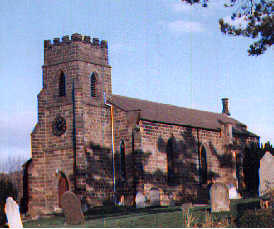  Holy Trinity
|
||||
|
||||
|
||||
|
|
||||
|
Holy Trinity Church stands on a slight rise near the centre of the
village and was built in 1839 and consecrated in 1840. Prior to that
date, Tansley was in the Parish of Crich. In a petition, the
parishioners of the time felt that “ ........ the hamlet of Tansley
contains a population of upwards of 500 souls and is distant from the
Parish Church of four miles and that it is extremely inconvenient for
the inhabitants of the said hamlet to attend divine service in the said
Parish Church of Crich, and in order to provide some church
accommodation and aid for spiritual wants of the people residing therein
considerable funds have been raised by voluntary contributions together
with other grants of money to erect a chapel.”
|
||||
|
The ‘chapel’ was designed by John Mason of Derby and built from stone
quarried in the local Fox Holes and Knowle quarries. In order to defray
expenses, ten local inhabitants promised to pay a total of £29 for the
carriage of stone. The charges were to be 1 shilling (5p) per load for a
one-horse cart and man and 1 shilling and 8 pence (8p) for a two-horse
cart and man from Fox Holes quarry and 7 pence (3p) and 1 shilling (5p)
respectively from Knowle quarry. A one-horse cart had to be not less
than 16 hundredweights (812 kg) and a two-horse cart not less that 30
hundredweights (1524 kg).
|
||||
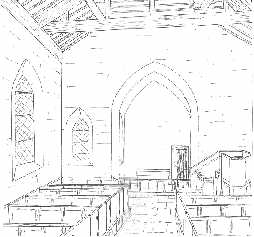 |
||||
|
The church was smaller and much plainer than it is now as the North
aisle was added 30 years later. From the plans of the church, it appears
that the pulpit was of the double-decker type. There were seats for 230
people. The first eight rows were “paid seats” and were rented by
parishioners to provide a stipend for the minister. These pews were
closed with doors.
The remaining nine rows (120 seats) to the rear were free for the use of the poor. Music was provided by a small orchestra situated in a small singing gallery built into the tower at the west end of the church. |
||||
|
An insight into how Holy Trinity church looked at the time it was built
can be gained by visiting Christ Church at Hulland, not many miles from
Tansley. Christ Church was also designed by John Mason from Derby and was
completed in 1838 just two years before Holy Trinity. Comparison of the two churches shows that the same basic design was used for the two buildings except that the design for Tansley was on a slightly larger and more ornate scale. Holy Trinity was slightly bigger, the tower taller with butttresses and pinacles and the furnishing inside possibly a little more ornate. The interior of Christ Church has not changed very much since it was built so we can still see the box pews, double pulpit, font, gallery, main door and the windows. Christ Church still has its singing gallery and stairs to it from the porch which now provides access to the gallery so all this gives us a good picture of what Holy Trinity looked like in 1840. |
||||
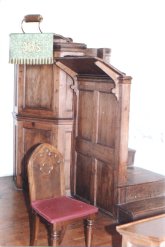 Hulland Christ
Church Hulland Christ
Church |
||||
 Tansley Holy
trinity Church Tansley Holy
trinity Church |
||||
| Although the original 2-tier pulpit for Holy Trinity no longer exists, the drawing in the original plan of the church shows a rather more elaborate but a not too dissimilar pulpit to that which is still in use in Christ Church. | ||||
 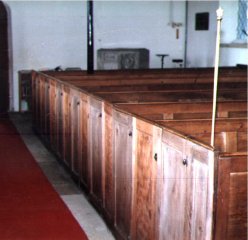 |
||||
|
This composite picture of box pews at Christ Church, Hulland, shows what
the interior of Holy Trinity Church might have looked like in 1840.
|
||||
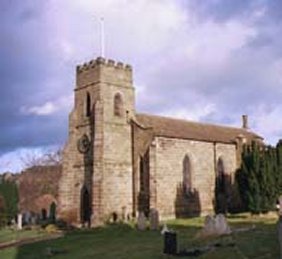 |
||||
|
The church was finished and opened on the 12th July 1840 at a service
conducted by the Vicar of Crich. The photograph, taken from the South
side, shows the church as it would have looked in 1840, except for
gravestones and yew trees. The church was consecrated two months later on the 18th September 1840 by the Bishop of Lichfield in the name of “The Holy Trinity” A distinguished congregation must have attended as the collections for the day amounted to £50 10s 6d, a considerable amount of money for those days. Tansley was still part of the Parish of Crich but in 1844 a Chapelry District of Tansley was formed which embraced just the village of Tansley. Twenty years later, Tansley Chapel was obviously thriving because in 1865 a new Parish of Tansley was formed which now included the hamlet of Riber and the houses in the adjacent industrial valley of Lumsdale.
|
||||
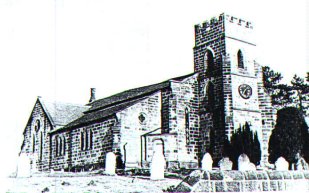 |
||||
|
By the middle of the 1860s, Matlock Bank, just over a mile away, had
become popular with visitors coming to take the waters and although Holy
Trinity church was large enough for local residents, it was not big enough
to cope with additional visitors from Matlock Bank. The church was
enlarged in 1870 by adding a North Aisle. New pews replaced the box pews
and the altar area was changed. It was recognised that the addition of one
aisle “ ..... produced an oddity but it is intended to add a
corresponding wing should further accommodation be necessary”. In the
event, it obviously did not prove to be necessary.
The re-opening service was held on Wednesday 26th Sptember 1870 and the
preacher was the Bishop of Madras. There were three services that day. The
morning congregation obviously consisted mainly of invited guests as the
collection amounted to £29 10s 10d. The afternoon service yielded a
collection of £10 3s 4d whilst the evening service “...... where there
was a large collection of villagers” yielded only £3 1s 7d."
|
||||
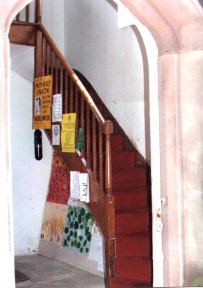 Christ Church
porch Christ Church
porch |
||||
|
The date of installation of the gallery in Holy Trinity church is somewhat
of an enigma. The plan of the layout of the church displayed in 1840 does
not show a gallery but shows stairs going up from the porch to the singing
gallery in the tower just as can be seen today in Christ Church, Hulland.
However the width of the interior of the porch in Holy Trinity does not
seem wide enough to have accommodated stairs. The gallery at Holy
Trinity was present in 1896 as the floor of the gallery had to be lowered
to take the new organ. It could have been installed in 1870 when the
church was enlarged by the addition of the North aisle but the style of
the gallery is not that of the architects of the time. |
||||
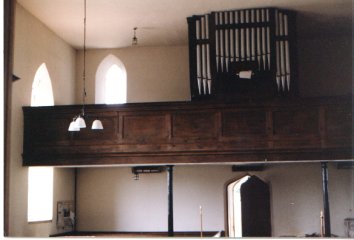 Christ Church Christ Church |
||||
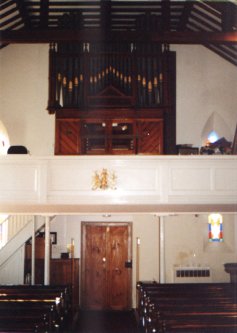 Holy Trinity Holy Trinity |
||||
| The gallery at Christ Church is identical to that at Holy Trinity both in design and construction | ||||
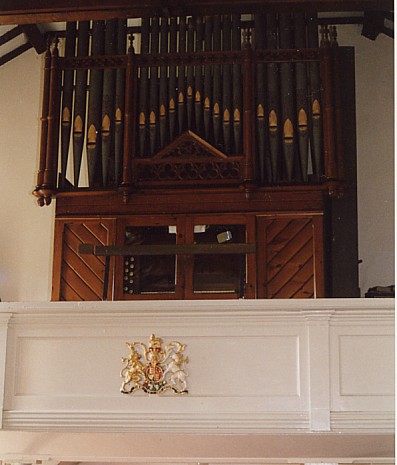 Holy Trinity Holy Trinity |
||||
| Many of the Established churches displayed the Royal Arms somewhere in the church. Often these were painted on a wall but here in Holy Trinity there is a fine example made in cast iron which is attached to the front of the gallery. It is in excellent condition, having been refurbished in beautiful colours by the Revd John Drackley some years ago | ||||
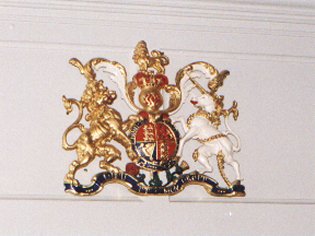 |
||||
|
As the Revd Drackley says .... The arms would be more probable c1840
than later. Their significance at Tansley may be related in part to the
pre-existence in the village of a thriving Methodist congregation. By
putting the Royal Arms in the church the founders were asserting the
primacy of the Established Church as the ‘official’ religion - ‘By
Appointment’ .
|
||||
|
“The organ, situated within the gallery, is an apparently typical
late Victorian organ of pitch pine and painted pipes .... This is a
splendid little organ, perfectly situated musically, acoustically and
visually. But there is more to this little organ than meets the eye.
...... “ (Rodney Tomkins, Derby Diocesan Advisor for Organs) Tansley, like so many other churches probably started its life with a small band to provide musical accompaniament. Evidence for this comes from Mr Frank Bithel (violin and cello maker) of Wensley who remembers a cello which he had in for repair in the 1970s which had a label pasted inside claiming the instrument had been played in Tansley Church to support the singing.
|
||||
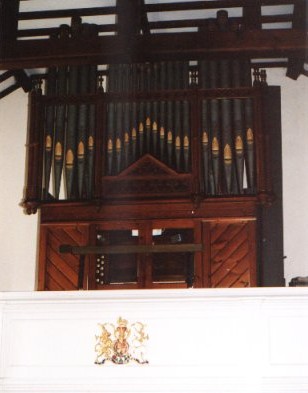 Holy trinity
organ Holy trinity
organ |
||||
|
Ten years after the church was built, in 1850, a second-hand barrel organ
with 5 stops and 5 barrels (each with 10 tunes) was bought from the church
at South Elkington (Lincolnshire) for £35 5s 0d and installed in church.
Barrel organs were used at this time in churches to accompany the singing of hymns but they were not like the barrel organs we see today. They had sets of pipes and were driven by a wooden barrel with pegs mounted in the face. The barrel was turned by a handle which also operated the bellows and the organs were vehicles for music of the highest quality. Handel, Mozart and Haydn all wrote music for mechanical organs.
|
||||
|
A few years after obtaining the barrel organ it was converted to a Manual
pipe organ and eventually into a pedal organ. By 1893 however, there was
need for a new organ as the old organ was “...... completely worn out
and not fit for use”. A fund was set up to raise £150 and in January
1896 John Stacey from Derby gave an estimate for a new organ. The old
organ was removed to his works early in 1896 and a new 2-manual organ was
constructed where he used 5 stops from the old barrel organ in the new
organ. It is still possible to see that the middle compass of the Swell
pipes, equivalent to that of a small barrel organ insrument, consists of
much older material. Five months later he wrote “I hope to bring you the organ on Thursday next, i.e. if we can have the van and horses. I have just been after them but they are all off hay making”. In a letter dated 22nd July 1896 he says “I thank you very much for sending me the pliers and I hope you will find the round-nosed ones, they might be left in the swell box. ......” In a letter enclosing his final account he writes “I enclose you my little account for the organ and as soon as it is convenient I shall be glad to hear from you as money is always useful as you are perhaps aware”. |
||||
|
So today’s organ contains 5 stops from the original barrel organ and as
Rodney Tomkins says in his book “Pipe Organs of the Derbyshire Derwent” (ISBN 0 907758 88 6) “, .... we are still left with an instrument, some of whose pipework still displays the undoubted charm of early 19th century organ tone. This is, without doubt an instrument of interesting and historic character” |
||||
|
http://freespace.virgin.net/denys.gaskell/index2.html
|
||||
|
||||
|
||||
|
Pictures kindly supplied by |
||||
|
|
||||
|
|
||||
